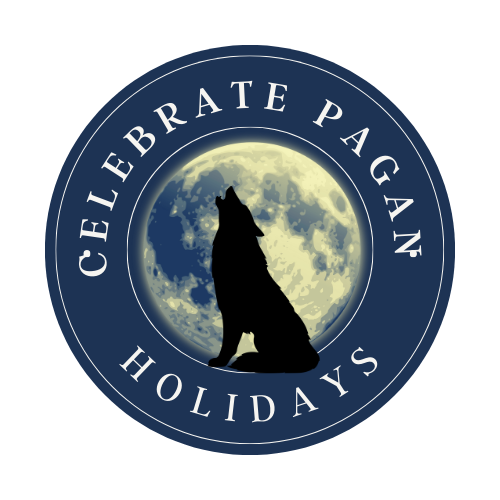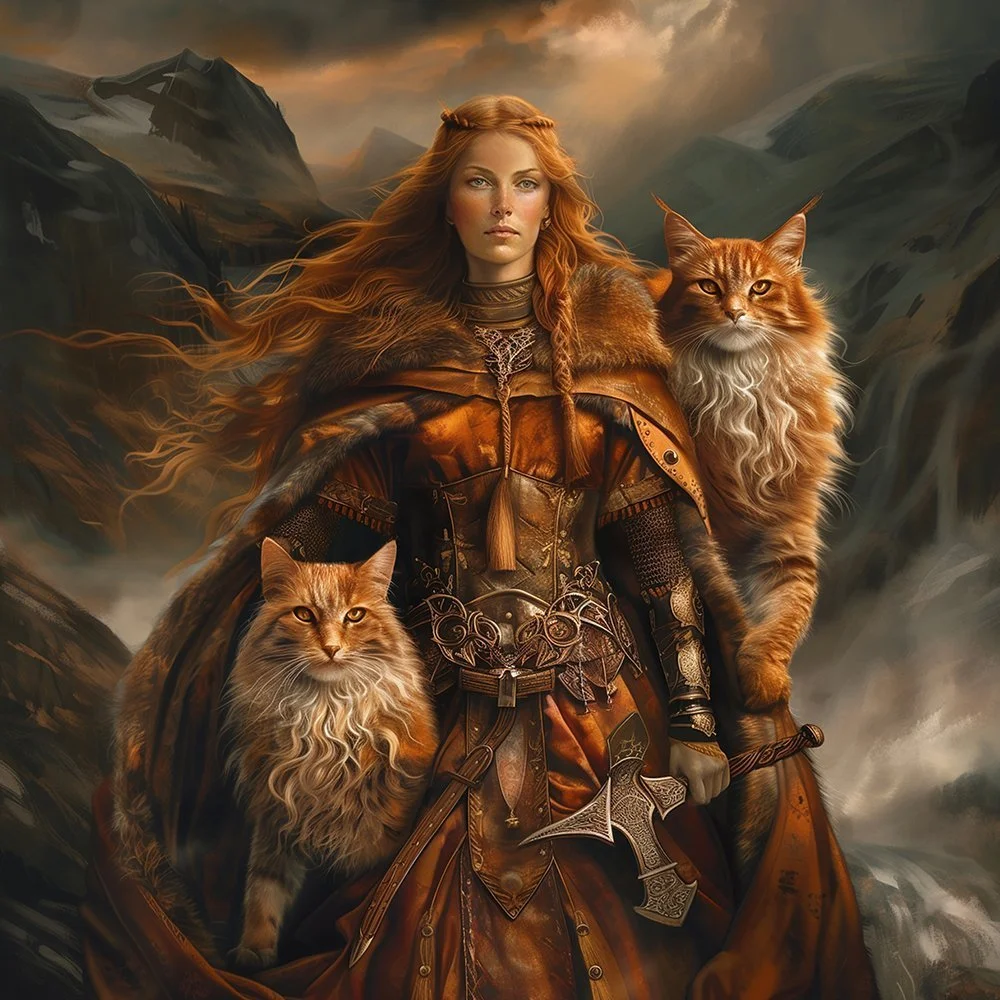Norse religion, also known as Germanic paganism or Heathenry, is a spiritual path that has deep roots in the traditions of Scandinavian and Germanic peoples, dating back to roughly the 1st century CE.
Far from being a primitive belief system, Norse religion is a sophisticated worldview that continues to shape the lives of modern practitioners across the globe.
The Norse religion thrives today. As with many modern pagan religions, there are various branches that people follow such as Asatru, Forn Sed, Vanatru, or Heathenry among others. For the most part, they all embellish the following beliefs which come from the ancient Nordic people.
Understanding our core beliefs offers us profound insights into how we can make sense of existence, death, honor, and the cosmos itself.
Odin and Frigg
Polytheism
Belief in multiple Gods and Goddesses as well as mythical creatures.
A unique trait in Nordic deities is that they are not immortal and could die. They were real people with families, emotions, strengths, and weaknesses. Today we put them in three groups.
The main Gods are part of the Aesir tribe or the deities of justice or wisdom (Odin, Frigg, or Thor) Read more about Odin.
Gods of natural forces, fertility, magic, are the Vanir group (such as Freyja and Freyr)
The giants, Jötunn, represent chaos and destruction and are at war with the Aesir Gods.
The Norns are not goddesses but three women who represent the past, present, and future. Their job is to care for Yggdrasil.
2. No Dogma or Written Scripture
Dogma is a set of beliefs that all members of a religious or even a political group believe and practice. An example of dogma is the Bible.
Unlike many modern religions with their detailed theological texts and strict interpretations, Norse beliefs are remarkably flexible and vary from region to region. There is no single "correct" way to practice the faith, no central religious authority, and no standardized scripture.
This doesn't mean Norse religion is chaotic or without structure. Instead, it is a living tradition passed down through stories, poetry, and practice. The closest things to religious texts are the poems and sagas that preserve myths and legends, but these are understood as cultural treasures rather than divine commandments.
The famous Prose Edda and Poetic Edda, compiled by Snorri Sturluson in the 13th century, are our best sources for understanding Norse mythology, but they represent just one interpretation of beliefs that have countless variations.
3. End of the World
Perhaps the most distinctive aspect of Norse religion is its belief in Ragnarok—the prophesied end of the current world order. This isn't simply an apocalypse in the Christian sense, but rather a cosmic renewal that will destroy the old world to make way for something new and better.
The prophecy of Ragnarok tells of a time when the bonds holding the cosmos together will weaken and break. The wolf Fenrir will devour Odin, the Midgard Serpent will poison the sky, and the fire giant Surtr will burn the world. Many gods will die, including Thor, Odin, and Freyja. The World Tree itself will shake, and the old order will collapse.
But Ragnarok is not the end of the story. From the destruction will emerge a new world, green and fertile, where some gods will return, new gods will arise, and humanity will begin again. This cyclical view of time is radically different from linear Christian concepts of history moving toward a final judgment.
The belief in Ragnarok has profound implications for how Norse practitioners live their lives. If the gods themselves are mortal and the world is temporary, then what matters is not achieving permanent victory but facing challenges with courage and dignity.
The gods are not all-powerful beings to be worshipped from afar, but rather allies and examples in the cosmic struggle against chaos and dissolution. Better to fight bravely and lose than to surrender without struggle. This attitude shapes everything from personal ethics to political strategy.
4. Afterlife
The afterlife has several forms. Valhalla, Folkvangr, and Helheim are the three we are most familiar with. They are not equivalent to heaven and hell and your behavior on earth does not earn you a place in one or the other.
The most famous destination for the dead is Valhalla, Odin's great hall where warriors who die in battle feast and fight until Ragnarok. However, this is far from the only option, and contrary to popular belief, not all Norse practitioners expect or even want to go to Valhalla.
Folkvangr, ruled by the goddess Freyja, receives half of all battle-slain warriors. This realm is considered just as glorious as Valhalla, and some sources suggest it might be preferred by certain warriors.
Hel, the realm of the goddess of the same name, is the destination for those who die of illness, old age, or accident. Contrary to Christian-influenced interpretations, Hel is not a place of punishment but simply a different kind of afterlife—quieter perhaps, but not necessarily worse.
You might simple continue your existence in the burial mound or mountain where you were buried. If you died at sea the goddess Ran may claim you.
What unifies these beliefs is the understanding that death is not an ending but a transition. The dead can still influence the living through dreams, omens, and direct intervention.
We have a great article, Norse Afterlife By Goði Anlengðarclan. Check it out to read more on this subject.
5. Honor
True honor goes beyond physical courage. There is honor in being a warrior and fighting for what you believe in. There are many Norse men and women, in the US Armed Forces, that desire to protect our country and help during national disasters.
This is not necessarily a call to violence. Ásatrú, as it has been practiced in Iceland, is a religion of nature and life, stressing the harmony of the natural world and the search for harmony in the life of individuals.
Honor encompasses Loyalty to one's fellowship (felag), family, and community is also very important.
A ‘drengr’ or brave warrior is a man or woman of honor. They are expected to show fairness and respect for others.
6. Ancestral Deities
Ancestors are honored and consulted, and their wisdom is sought in times of trouble. This creates a sense of continuity between generations and reinforces the importance of maintaining family honor.
Your ancestors played a big part in your family and clan life. Communication with the ancestors assures the well-being of everyone. Ignoring them can bring bad luck.
This is known as ancestor veneration and is a key aspect of Norse paganism, where practitioners honor their forebears, seeking guidance and wisdom from their ancestral spirits, emphasizing the importance of lineage and heritage.
Freyja and her cats
7. Sacred Animals
These animals or familiars had a connection to the Gods or were in the presence of the Gods. Common animals included cats, eagles, goats, ravens, and wolves.
Read my article Norse Gods and Their Spirit Animals
8. Yggdrasil
Yggdrasil is the universal tree that connects the realms. An evergreen ash tree, it stands in the middle of the world.
9. Blot
Blót is the Old Norse word for sacrifice or traditional “blood sacrifice” where an animal is ritualistically sacrificed. Blót is performed for a variety of reasons, including a connection with our agricultural past. It brings fertility of the land, promotes a good harvest, and maintains peace.
Obviously, today an animal in certain areas would be illegal as well as immoral. Unless your a farmer and your slaughtering an animal for your own consumption. We can still celebrate a blót as communal worship time with food and drink.
During this time we can communicate with the Gods, offer gifts, and ask for help from them.
10. Community
The Ancient Nordic people did not separate their daily life from their “religious” life. The community was important and the divine is present in all things.
Today Norse pagan communities may be referred to as Kindreds, Hearths, or Garths.
WYRD
Wyrd has to do with the connectivity of everything in the universe. So your actions (or inactions) become very important.
11. No Proselytizing or Missionary Work
Unlike in Christianity where followers are called up to try and convert others, the Norse religion does not try to preach to other people.
Christians often aggressively go after pagans and try to shame them. At least once a day I have to erase comments from the website and YouTube channel because I dont want that nasty energy.
Source of Knowledge
You may wonder - how do we know all of this?
Norse religion does not have a tenet like Christianity has the Bible. However, there are several texts that give us information on how the Nordic religion was practiced by our ancestors.
Snorri Sturluson was an Icelandic historian who wrote profusely during the early 1200s. He was a lawspeaker (keeper of laws) in the Icelandic parliament and wrote a Saga called The Prose Edda.
Sagas are written prose that tells the history and life of the Scandinavian and Germanic peoples. Beowulf is a famous saga.
Tacitus was a Roman historian who wrote about the religion of the Germanic peoples in 100 AD.
Archaeologists have unearthed numerous pieces of art, jewelry, furniture, and other symbols of religious life. We know about this faith due to oral histories, written accounts, artwork, and archaeological excavations.
Controversy
In a few modern groups of Norse pagans, racists have incorporated elements of ancient Nordic religion because they believe it reflects their worldview. This has created controversy with the majority of Norse and Heathen pagans who state that the Nordic belief system doesn’t teach any one race is superior to another.
Here at Celebrate Pagan Holidays, we are open to all people who want to learn more and pursue a pagan lifestyle. As stated in our mission: We are inclusive of all pagans and welcome persons from different ethnic, cultural, and racial backgrounds, and embrace persons of all genders.
Continued Growth
Norse paganism never really went away with the conquering of Christianity. In fact, it was incorporated into many Christian beliefs. Read “Do Pagans Celebrate Christmas” to learn more.
An Icelandic farmer and author, Sveinbjörn Beinteinssn, co-founded the Æsir Norse Religious practice in 1972. This group grew quickly in Iceland and has spread to North America and Great Britain, especially among people with Scandinavian heritage.
As a whole, pagans are gaining in population in the USA and Great Britain where they are counted in the census.
Author, Erik recently graduated with a degree in Anthropology and is working as a museum curator. Erik desires to be a Viking when he grows up and has worked in Outdoor Adventure leading hikes and rafting trips. He is the author of The Complete Guide To Become a Norse Pagan.













This is a question that many religious people have been asking themselves lately. In the past, it was commonplace for religious individuals to wear beards as part of their religious attire.
But now, with so much attention being focused on workplace safety and company image, more and more companies are starting to say no to religious facial hair in the workplace.
Should pagans be allowed to wear a beard in the workplace? Let's take a look at some of the arguments for both sides!